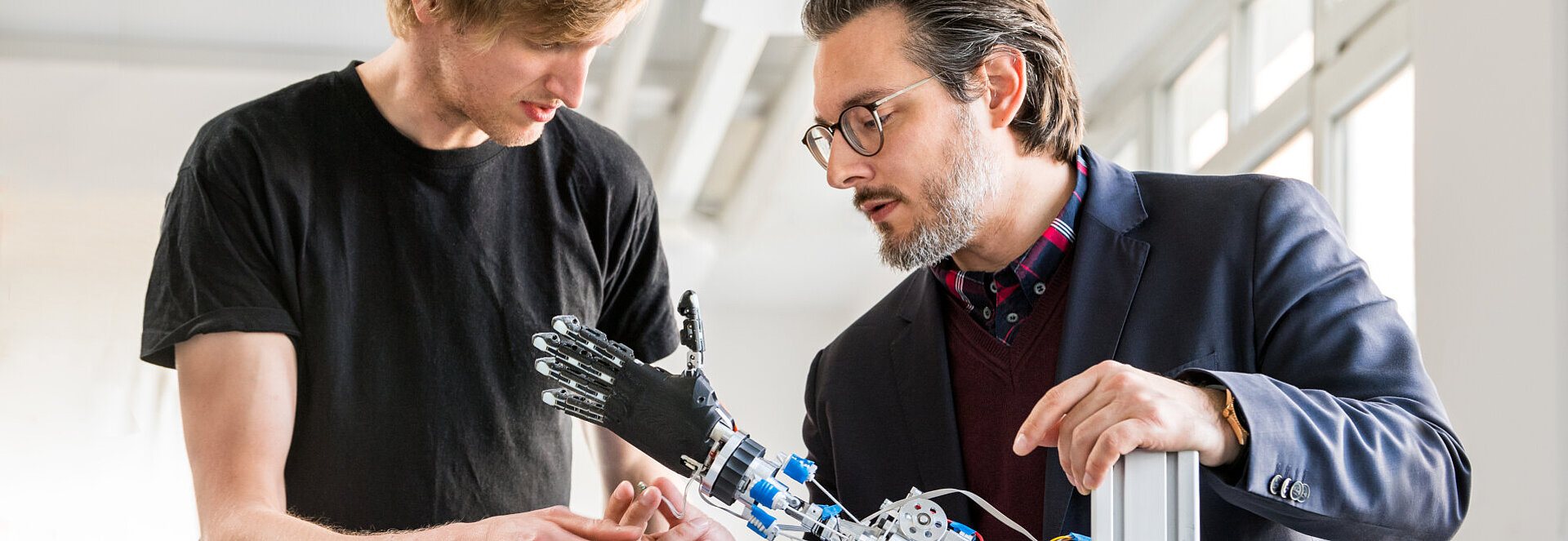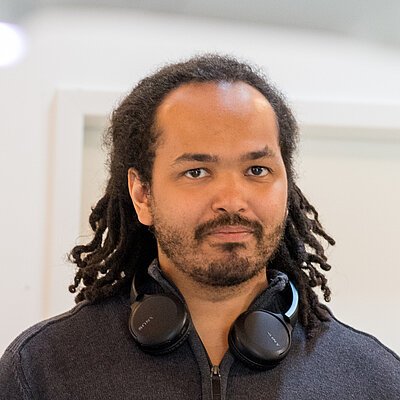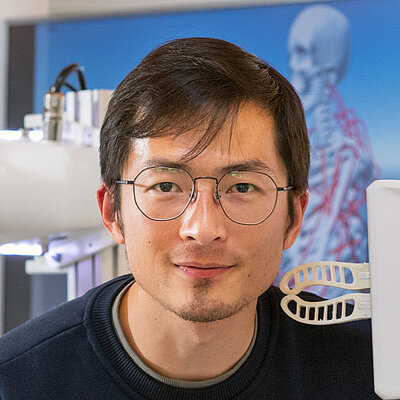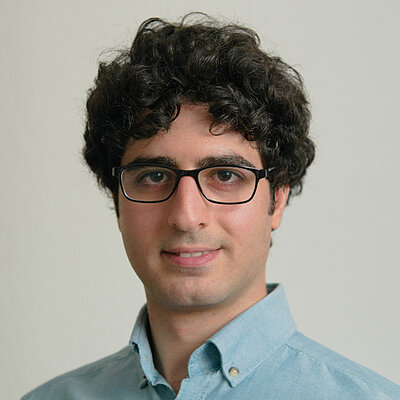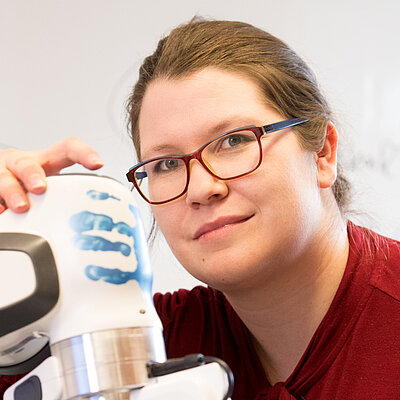Intelligent Robots for Everyday Life
Interactions between people, robots, and artificial intelligence (AI) will soon be a common part of everyday life. They will also be much more direct. For Professor Sami Haddadin, the founding director of the Munich School of Robotics and Machine Intelligence (MSRM) at the Technical University of Munich, this is a certainty. Robots and intelligent machines are set to transform the way we live and work over the coming years—and as machines evolve, they will increasingly collaborate with humans, which means that safe, intuitive interaction is a must.
We’re looking for creative minds who can contribute their own questions and knowledge.Prof. Sami Haddadin, Founding director, MSRM
“We have the opportunity to create something unprecedented,” says Haddadin, who joined TUM in 2018 to start up the MSRM, despite offers from Stanford and MIT. Since the institute first opened its doors, not only has Haddadin won the prestigious Leibniz Prize, but the German chancellor Angela Merkel and the Bavarian minister president Markus Söder have visited to experience its intelligent machines up close. During the corona pandemic, Microsoft CEO Satya Nadella came along virtually to videochat with Haddadin and students about what the future holds for AI and robotics. The MSRM has even established a further research project at the foot of the Alps, in Garmisch-Partenkirchen. Here, postdoc and PhD researchers are developing personal robot assistants that could one day support elderly people in their daily lives.


Munich – A Hotbed of Robotics
“Munich is the ideal location for the MSRM,” says Haddadin. “There are excellent researchers here along with outstanding expertise in the private sector.” Big companies, for example in the electronics and automotive sectors, and creative high-tech start-ups are cooperating closely with the MSRM. An industrial advisory board with executives from Siemens, BMW, IBM, Airbus, and other enterprises helps the scientists align their basic research with problems arising from real-world applications.
There are excellent researchers here along with outstanding expertise in the private sector.Prof. Sami Haddadin, Founding director, MSRM
What’s more, the Bavarian government has put the MSRM at the center of its Hightech Agenda to form a new “AI Mission Institute” that combines scientific and entrepreneurial endeavors, and which is linked up to specialized AI research centers across Bavaria. One hundred new professorships in robotics and AI are to be created by the Bavarian government, several of them at TUM. In light of these developments, TUM’s president, Thomas F. Hofmann, has no doubt that together, the MSRM, its Bavarian AI research network, and Bavaria's vibrant start-up scene will “combine to create a region for world-class innovation in AI.”
Interdisciplinary Research under One Roof
The MSRM is one of TUM’s integrative research centers, which connect scientists across traditional disciplines. As such, it brings together robotics and AI experts who have spent years working in their specialized areas: more than 50 professors in disciplines from robotics and mechatronics to machine learning and perception, to computational neurosciences and molecular machines.
At the MSRM, they map out forward-looking questions at the intersections of their fields. In short, they create exciting projects for creative and inquisitive PhD students and postdocs to pursue in interdisciplinary focus groups. More than 800 early-career scientists work with the 50+ professors who are linked up by the MSRM, whether on the Garching high-tech campus north of Munich, the university hospital, Klinikum rechts der Isar or at the MSRM’s home base at the edge of Munich’s Schwabing district.

The Creators of Robotic Fine Motor Skills
Haddadin’s own research group has already grown to around 60 scientists from around the globe. Their work on machine learning is considered ground-breaking because it opens up a completely new perspective on the way robots are designed and built, how they learn, and how they are programmed.
“You could call us the creators of robotic fine motor skills,” says Haddadin. What they are enabling robots to do is acquire new skills similar to how three-year-old toddlers develop their fine motor skills. Using minimal computing powers, the machines collectively try out new tasks like inserting a key into a lock or a simple handshake. They refine their skills with a few attempts, and pass the lessons learned on to the other connected robots. Such fine motor skills require a gentle sense of touch and intelligently interpreting the surroundings, which is crucial for any future robot that is to interact safely with people in their every-day lives.


Robotics for Medicine, Industry 4.0, and Mobility
Basic science and its real-world application are never far apart at the MSRM. As diverse as the different projects might be, they follow an innovation agenda with three specific research strands: The “future of healthcare” explores how, for example, robots and AI could support elderly people. The “future of work” concentrates on safe interaction of factory workers with machines as networked tools with learning capabilities. And the “future of mobility” means more than just self-driving cars. What about, say, swarms of autonomous drones exploring locations too remote and dangerous for humans to access?
Still More Room for Creative Scientists and Students
The school still is not finished recruiting talented people. “We’re looking for creative minds who can contribute their own questions and knowledge,” says Haddadin. Together, they will help train the robotics and AI researchers of tomorrow by setting up new degree courses, from bachelor to graduate programs. What students learn here will go beyond just mastering technology. Rather, they will use it responsibly for the benefit of people and societies, in keeping the MSRM’s—and the entire university’s—research philosophy: towards human-centered engineering.
Geriatronics Lighthouse Initiative
What is Geriatronics, actually?
Geriatronics is a new term to describe the combined use of innovative technologies in geriatrics, gerontology, and medical care to support elderly people and to relieve caregivers. It covers fields like robotics, mechatronics, and information technology, in particular machine intelligence and 3D technology.
What is the Geriatronics Lighthouse Initiative all about?
The project aims to enable elderly people to live a self-determined life in their own home using intelligent robotics.
A specialized lab in Garmisch-Partenkirchen has been set up as a satellite to the MSRM’s Munich headquarters. The main target of applied research is GARMI the autonomous robot. GARMI will one day be able to help people get dressed, or even assist doctors or emergency services in telemedicine scenarios. For instance, by measuring blood pressure or recording ultrasound images while the doctor talks to the patients via GARMI’s video head.
Researchers are currently developing sensitive humanoid hands with low-level control algorithms, an innovative multimodal head, and a multimodal input device for medical professionals, which they will be able to operate from remote locations.
Can PhD students and postdocs still join the initiative?
Yes! The geriatronics team is looking for PhD researchers in robotics, and for postdocs to work on humanoid robots, computer vision, and artificial hands.
Visit our open positions.



